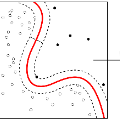Graph-based anomaly detection has been widely used for detecting malicious activities in real-world applications. Existing attempts to address this problem have thus far focused on structural feature engineering or learning in the binary classification regime. In this work, we propose to leverage graph contrastive coding and present the supervised GCCAD model for contrasting abnormal nodes with normal ones in terms of their distances to the global context (e.g., the average of all nodes). To handle scenarios with scarce labels, we further enable GCCAD as a self-supervised framework by designing a graph corrupting strategy for generating synthetic node labels. To achieve the contrastive objective, we design a graph neural network encoder that can infer and further remove suspicious links during message passing, as well as learn the global context of the input graph. We conduct extensive experiments on four public datasets, demonstrating that 1) GCCAD significantly and consistently outperforms various advanced baselines and 2) its self-supervised version without fine-tuning can achieve comparable performance with its fully supervised version.
翻译:以图表为基础的异常现象探测已被广泛用于探测真实世界应用中的恶意活动。迄今为止,解决这一问题的现有尝试侧重于结构特征工程或二进制分类制度中的学习。在这项工作中,我们提议利用图表对比编码,并展示受监督的海合会开发模型,从异常节点与正常节点的距离与全球环境的距离(例如所有节点的平均数)进行对比。为了处理带有稀缺标签的假想,我们进一步使海合会成为一个自我监督的框架,为此设计了一个用于生成合成节点标签的图表腐蚀战略。为了实现对比性目标,我们设计了一个图形神经网络编码器,在信息传递过程中可以推断和进一步删除可疑的链接,并学习输入图的全球背景。我们在四个公共数据集上进行了广泛的实验,表明1 海合会显著和一贯地超越各种先进的基线,2 未经微调的自上调版本可以与其完全监督的版本取得可比的性能。



